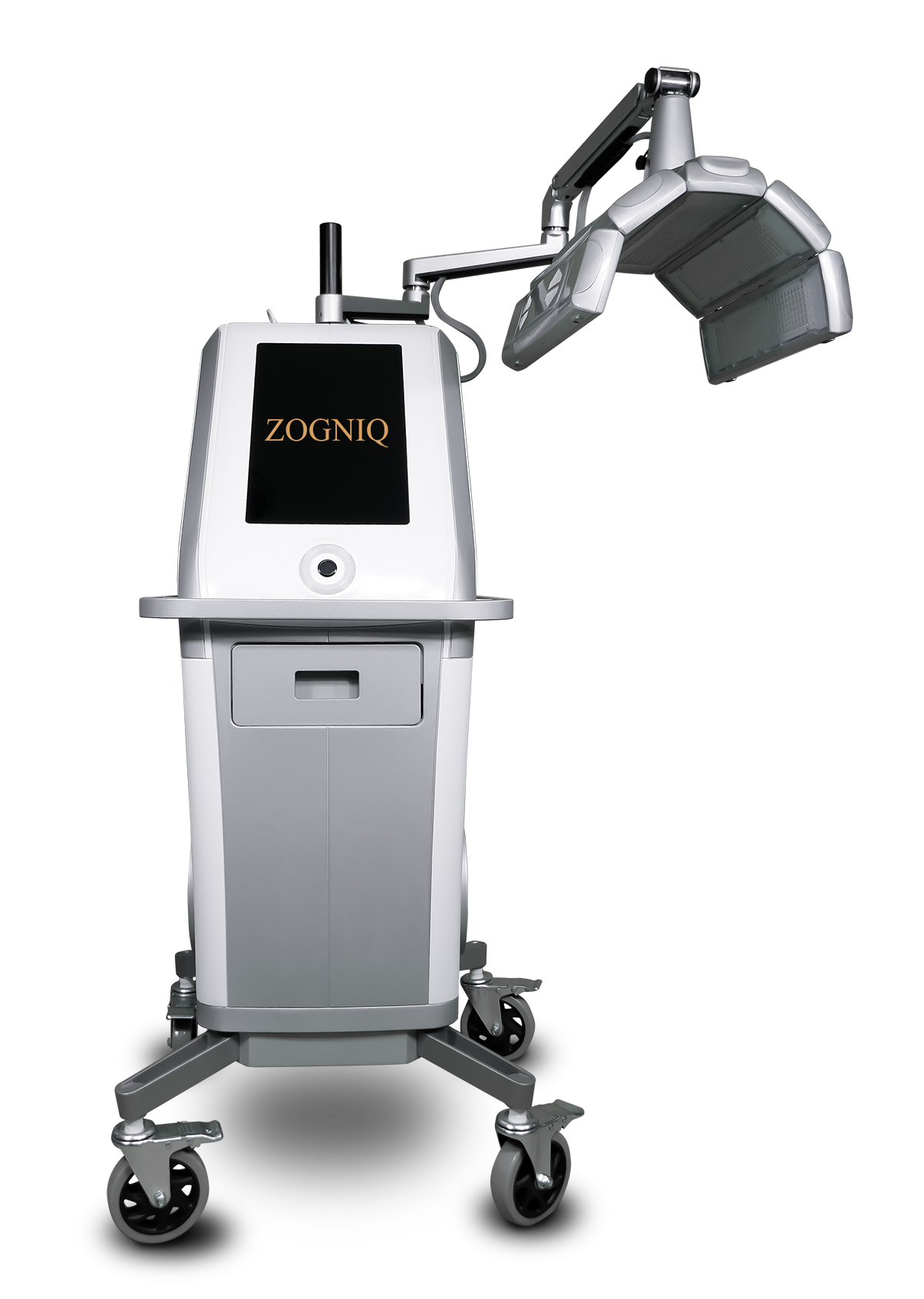ZogniQ’s ZPL Polarized Light Therapy is Based on Research
We developed Zogniq’s Polarized Light Therapy (ZPL) as the outcome of extensive scientific investigation and deliberate engineering. ZPL is a specialized form of photobiomodulation (PBM) that delivers light with a defined orientation of electromagnetic waves—polarization—engineered to achieve greater consistency and therapeutic reliability.
In designing this technology, our team conducted a comprehensive review of the scientific literature across photobiology, ophthalmology, dermatology, and biophysics. This process involved evaluating the limitations of standard low-level light therapy (LLLT) and identifying areas where polarization could provide measurable improvements. Device parameters, optical configurations, and treatment protocols were established on the basis of published findings, ensuring that the engineering approach was directly aligned with available clinical and preclinical evidence.
The following references illustrate a portion of the research base that informed the development of Zogniq’s ZPL Polarized Light Therapy and support its use as a clinically relevant advancement in photobiomodulation:
Clinical Evidence
Nicholas Tripodi, Fotios Sidiroglou, Sarah Fraser, Maja Husaric, Dimitrios Kiatos, Vasso Apostolopoulos, Jack Feehan,The effects of polarized photobiomodulation on cellular viability, proliferation, mitochondrial membrane potential and apoptosis in human fibroblasts: Potential applications to wound healing, Journal of Photochemistry and Photobiology B: Biology, Volume 236, 2022, 112574, ISSN 1011-1344, Austin E, Koo E, Merleev A, Torre D, Marusina A, Luxardi G, Mamalis A, Isseroff RR, Ma’ayan A, Maverakis E, Jagdeo J. Transcriptome analysis of human dermal fibroblasts following red light phototherapy. Sci Rep. 2021 Apr 1;11(1):7315. doi: 10.1038/s41598-021-86623-2. PMID: 33795767; PMCID: PMC8017006. Tripodi N, Feehan J, Husaric M, Kiatos D, Sidiroglou F, Fraser S, Apostolopoulos V. Good, better, best? The effects of polarization on photobiomodulation therapy. J Biophotonics. 2020 May;13(5):e201960230. doi: 10.1002/jbio.201960230. Epub 2020 Feb 27. PMID: 32077232. Sund SE, Swanson JA, Axelrod D. Cell membrane orientation visualized by polarized total internal reflection fluorescence. Biophys J. 1999 Oct;77(4):2266-83. doi: 10.1016/S0006-3495(99)77066-9. PMID: 10512845; PMCID: PMC1300506. Lv G, Tu Y, Zhang JH, Chen G. Photomolecular effect: Visible light interaction with air-water interface. Proc Natl Acad Sci U S A. 2024 Apr 30;121(18):e2320844121. doi: 10.1073/pnas.2320844121. Epub 2024 Apr 23. PMID: 38652751; PMCID: PMC11067046.ZogniQ Clinical Quick Reference Matrix
| Study | Year | Model/Setting | Light | Key Findings | Parameters |
| Tripodi et al., 2022 | 2022 | Human dermal fibroblasts (in vitro) | Polarized PBM vs non-polarized | ↑ proliferation, ↑ mitochondrial membrane potential, ↓ apoptosis; suggests improved wound-healing potential | 650–850 nm (mixed wavelengths), ~10 J/cm² (reported in paper) |
| Austin et al., 2021 | 2021 | Human dermal fibroblasts (in vitro) | Red light (not polarized) | Transcriptome changes: ECM remodeling, ↑ MMP1, antifibrotic effects | 633 nm, ~10 J/cm² |
| Tripodi et al., 2020 | 2020 | Preclinical review + in vitro | Polarization vs non-polarized | Parallel polarization improved wound closure, collagen organization | Visible/NIR spectrum, fluences 1–10 J/cm² |
| Sund et al., 1999 | 1999 | Cell membrane imaging (mechanistic) | Polarized TIRF | Showed membrane orientation affects polarized field interactions | 488–514 nm excitation |
| Pasek et al., 2024 | 2024 | Clinical RCT pilot, venous leg ulcers (n=40) | Polarized light adjunct vs sham | Greater ulcer area reduction (~33% vs 19%) and pain reduction (~71% vs 38%) | Bioptron lamp, polychromatic polarized 480–3400 nm, 10 min/session, 5×/wk, 10 wks |
| Allam et al., 2025 | 2025 | Review of wound healing studies | Polarized light (broad spectrum) | Summarizes accelerated healing, deeper penetration, cost-effective; more trials needed | Not applicable (review) |
| Lv et al., 2024 | 2024 | Fundamental physics (air–water interface) | Visible light, TM-polarization | Photomolecular effect at interface; polarization alters water interactions | Visible spectrum, interface model |
| Taha et al., 2022 | 2022 | Clinical RCT, diabetic foot ulcers (n=40) | Polarized light (Bioptron) vs control | Ulcer size reduction (51% vs 25%), higher negative cultures (60% vs 15%) | Bioptron lamp, 480–3400 nm polarized, 10 min/session, 3×/wk, 8 wks |
| Feehan et al., 2020 | 2020 | Human monocytes (in vitro) | Polychromatic polarized light | ↓ IL1B, CCL2, NLRP3; ↑ NFKBIA, TLR9 → anti-inflammatory effect | 480–700 nm polarized, ~10 J/cm² |


